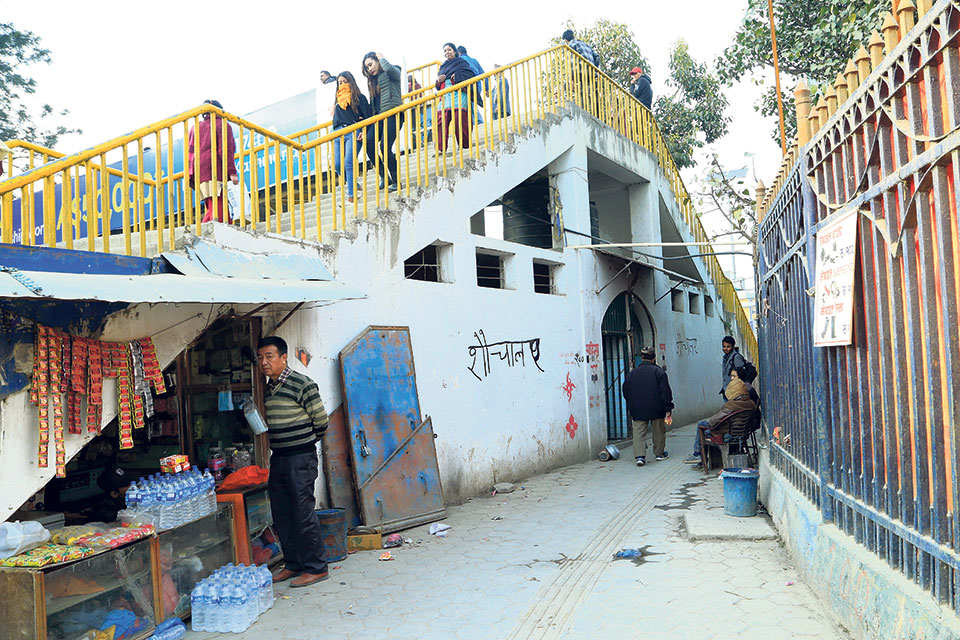February 3, 2019 07:30 AM SHUVAM DHUNGANA
KATHMANDU, Feb 3: Kathmandu Metropolitan City is mired in toilet crisis as the capital struggles to accommodate its growing population lured by job opportunities and other facilities. There are only 57 public toilets, more than half of them in need of immediate repair, in KMC which is home to millions of people.
This acute shortage of public toilets can trigger a sanitation disaster that could put thousands of lives at risk, experts have warned.
“The shortage of toilet together with poor hygiene could easily trigger a health crisis. The residents of Kathmandu face risk of various communicable diseases like diarrhea, dysentery and round worm infection,” said Dr Samir Kumar Adhikari of the Epidemiology and Disease Control Division under the Ministry of Health.
According to the government census of 2011, the Kathmandu Metropolitan City alone has a population of around one million while the population of Kathmandu district is nearly two million excluding the migrant workers, students and other people staying temporarily in the capital city. Officials estimate that the total estimated population of the entire Kathmandu Valley is around five million.
Officials say facilities such as public toilets in Kathmandu city have to be regularly upgraded as even visitors from immediate neighboring cities such as Lalitpur and Bhaktapur use them.
Despite pledges to improve the city’s sanitation problem in the run up to the parliamentary and provincial elections, KMC Mayor Bidya Sundar Shakya has done very little to address Kathmandu’s toilet woes.
A part of Kathmandu’s toilet crisis lies in KMC’s existing partnership with the private sector. Each year, KMC rents out the public toilets to private sector through bidding process, generating around Rs 9 million in revenue from restrooms.
Thanks to the dearth of public toilet, a public toilet in the valley draws an average of 3000 people each day. For most of the operators, it is an extremely lucrative business. But most of these toilets are poorly maintained and even unfit for use, Republica’s inspection of around a dozen public toilets in central Kathmandu has found.
The public toilet in old bus park serves around 5000 people each day. For Umesh Shah, its operator, it has turned out to be an extremely good business. But he spends precious little in maintenance of the toilet.
“The cleaner comes once a day for cleaning. That costs me Rs 100 each day,” Shah told Republica when asked about sanitation.
One public toilet in New Road that Republica visited was unfit for use. It lacked supply of water and the entrance was drenched in urine, causing problems to the passersby. Chandra Maya Deula, its operator, stopped hiring a cleaner due to decrease in income.
“I collect around Rs 800 per day as the toilet here is of very small size and I have to pay tax to the KMC,” Deula said. Deula claimed that she cleans the toilet herself once a day despite scarcity of water.
The poor state of public toilets means many people prefer open defecation over using them. Ramesh Khadka, a student at RR Campus, said that the government was playing with the lives of the people.
“It’s a punishment to use public toilets. There should be public campaign to force KMC officials to use them. Then only the situation will improve,” said Khadka.
KMC’s Spokesperson Ishworman Dangol admitted negligence in monitoring by KMC staff. He, however, said that his office has formed a task force to investigate about the current situation of public toilets. He said that plans are afoot to build new toilets based on the recommendation of the committee.
“We are planning to study about the situation of public toilets this year, and we will build necessary smart public toilets from next fiscal year. We are preparing working procedure this week for maintaining the existing public toilets,” said Dangol. “More than 60 smart toilets are currently being planned in various places of the city.”
According to a report prepared by the National Federation of Disabled, Nepal (NFDN), none of the 14 public toilets in the Kathmandu Valley that were chosen for a survey were found accessible to physically-challenged people. While 11 public toilets were found completely inaccessible, three were found partially accessible.
Source: My Republica

